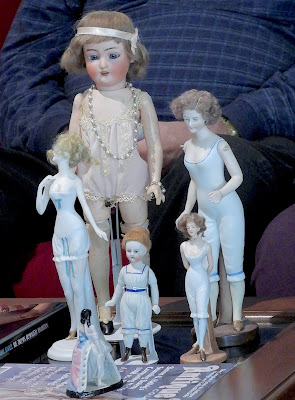Member Jan Irsfeld gave a program on the history of underwear. Member Myrna Loesch made these adorable and appropriate (and DELICIOUS) iced lingerie sugar cookies, as well as the small round shortbread cookies known as "petticoat tails." To complete the undergarment theme, she also provided a bowl of Ruffles potato chips.
Jan explained that early clothing was unstructured and undergarments were often nothing more than a piece of cloth wrapped around the loins. She holds an example of a Cissy by Madame Alexander that Jan dressed in a recreation of an ancient Egyptian garment.

Jan said that this changed in the era of Elizabeth the First, when clothing became increasingly structured, elaborate, and multilayered. Underwear not only protected the skin from chaffing and helped keep costly clothing clean, it served as a scaffolding to support the clothing, as well as to shape the body underneath. A hooped skirt called a farthingale acted as a frame to extend the skirt, a corset emphasized a lady's waist, and a bumroll accentuated the hips.
The 1700s introduced the pannier, side hoops that extended the width of a woman's skirts. Jan explained that the name comes from paired baskets that hung on each side of a donkey, typically used to deliver bread. The panniers were sometimes so wide that a woman had to move sideways through doors. Jan displayed a miniature pannier she created, along with the start of hand-beaded skirt that will go over it.

Jan stated that during the early 1800s, fashion took another turn and women wore high-waisted gowns with straight loosely-draped skirts, requiring very little in undergarments. However, by the 1860s, wide hoop skirts or crinolines were in style, supported by swinging bell-shaped cages of steel and whalebone. Crinoline cages were replaced by the bustle, a descendant of the bumroll. This is a miniature bustle created by Jan.
Starting in the 1900s, as women's clothing became less structured and complex, so did undergarments. The brassiere was introduced as women discarded their corsets and teddies replaced the layers of undergarments. Jan passed around examples of vintage bras and teddies designed by Madame Alexander for the Cissy fashion dolls.
Jan ended her program by sharing this limited edition "Cissy's Secret" by Madame Alexander. Issued in 1997, the set includes not only a Cissy doll, but also a trunk full of her luxurious lingerie.
Member Sharon Weintraub displayed this group of ladies showing the evolution of an undergarment called the combination. Combination underwear was introduced in the 1870s to reduce bulk under the fitted jackets and narrower upper silhouette of the period. The little all-bisque doll with the auburn wig has a molded early version of this undergarment, with short sleeves, a modest neckline, and long legs. Combinations were worn through the 1900s, becoming ever briefer, frothier and sheerer, the cuffs climbing closer to the knees as hemlines began to rise. By the 1920s, the combination was reduced to the flapper's chemise or teddy, as demonstrated by the all-original 1159 Simon and Halbig flapper doll.
Myrna shared these two Madame Alexander Cissettes, one wearing a slip and the other a lace teddy.
Member Sylvia McDonald brought her Käthe Kruse boy in his original undergarment. This doll belonged to her great-aunt and Sylvia thinks that her aunt received the doll around 1912. Sylvia said that Kruse dolls still come in a very similar "onesie."
Member Elaine Jackson shared several examples of vintage doll underwear. . .
. . .as well as this very unusual Madame Alexander doll with a composition head and cloth body. Elaine has redressed her as Alice in Wonderland, but who she was originally is still a mystery.
















This sounds like a wonderful program! Maybe it could be done as a presentation through the Regional Director so other clubs in other regions could enjoy it.
ReplyDelete